Pyramid Butterflyfish
Hemitaurichthys polylepis
Brightly colored butterflyfish are a typical coral reef fish, and they are often seen dashing along the ocean's gardens. They have disk shaped bodies, which is advantageous when navigating through narrow spaces. They can quickly move out of reach for predators, and most species have a dark bar through the eye, which successfully disguises it. Some species of butterflyfish have a false eyespot near their tail. The travel in pairs and mate for life. Despite these long term partners, these fish do not offer parental care for their young. They release their eggs into the water, and after hatching the larvae drifts with plankton for weeks or months. Butterflyfish are distinguished by small, brush like teeth. The family name, Chaetodontidae, is a combination of chaeto ("hair") and dentis ("tooth"). 24 species of butterflyfish are found in the Hawaiian Islands. In ancient Hawai'i, one general name for butterflyfish is kīkākapu meaning "strongly prohibited," and are described in several oli or chants as sacred. Other names are lau-hau, which means "leaf of the hau tree," or lau-wiliwili meaning "leaf of the wiliwili tree."
These schooling species of Pyramid Butterflyfish prefer depths of 40 feet or more, and are typically found near steep dropoffs. Their body has a solid white triangle rimmed with yellow, and their head is dark brown. As they rest near the bottom at night, the white pyramid darks to gray, which leaves a bright white spot in the center. The species name means "many scales". They grow up to 6 inches.
